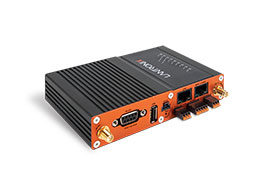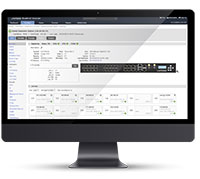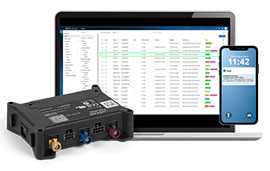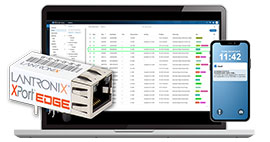| Parameter | Associated MIB variable | Description |
| Subdevice | cbftf100SubDeviceIndex(1) | See BIA, Slot, and Subdevice |
| BIA | cbftf100BiaIndex(2) | See BIA, Slot, and Subdevice |
| Slot | cbftf100SlotIndex(3) | See BIA, Slot, and Subdevice |
| Group Membership | cbftf100Groups(4) | See Configuration Management |
| Marketing Revision | cbftf100MRevision(5) | Marketing Revision |
| Config Match | cbftf100CfgMatch(6) | Configuration Management match? |
| Serial Number | cbftf100SerialNumber(7) | Serial Number reported by hardware |
| Configuration Mode | cbftf100ConfigMode(8) | Configuration Mode |
| Firmware Revision | cbftf100FirmwareRevision(9) | Firmware Revision of the switch |
| Self Test | cbftf100SelfTestFailed(10) | This variable indicates the status of the pass/fail power on test. If the power on test fails, normal operation of this device is probably not possible. |
| Spanning Tree | cbftf100SpanningTree(11) | This variable allows the agent to enable or disable Spanning Tree Protocol. Not all versions of the hardware support Spanning Tree. |
| Mirror Port | cbftf100MirrorCfg(12) | Mirror configuration |
| Source Address Change (master) | cbftf100SACMasterCfg(13) | Global enable/disable for Source Address Change detection functionality. When this variable is set to disabled the values in cgbtf100SACCfgTbl(27) are ignored. |
| Form Factor | cbftf100FormFactor(14) | A code corresponding to a physical configuration of the product. This code indicates the number of slots occupied and the number, type, and location of media connectors present. For details, see the MIB Module file. |
| Autonegotiation | cbftf100AutoNegotTbl(15) | Auto-negotiation configuration. |
| Duplex | cbftf100FullDuplexTbl(16) | Possible values are fullDuplex(1), halfDuplex(2), andnegotiating(3). On fiber ports, this variable has the read-only value fullDuplex(1). For twisted pair ports, it is either a configuration setting that controls the duplex mode (when auto-negotiation (cbftf100AutoNegotTbl) is disabled, or a status indication showing the duplex mode decided upon during negotiation (when autonegotiation is enabled). When link is down, autonegotiation has not been completed yet, and the duplex mode is therefore unknown and the value returned is negotiating(3). |
| Speed | cbftf100100MbpsTbl(17) | Possible values are 100Mbps(1), 10Mbps(2), andnegotiating(3). On fiber ports, this variable has the read-only value 100Mbps(1). For twisted pair ports, it is either a configuration setting that controls the link speed (when auto-negotiation (cbftf100AutoNegotTbl) is disabled, or a status indication showing the link speed decided upon during negotiation (when autonegotiation is enabled). When link is down, autonegotiation has not been completed yet, and the link speed is therefore unknown and the value returned is negotiating(3). |
| Advertised Mode 10Mbps HDX | cbftf100Adv10HDXTbl(18) | Enable/disable control for this advertised auto-negotiation mode. |
| Advertised Mode 10Mbps FDX | cbftf100Adv10FDXTbl(19) | Enable/disable control for this advertised auto-negotiation mode. |
| Advertised Mode 100Mbps HDX | cbftf100Adv100HDXTbl(20) | Enable/disable control for this advertised auto-negotiation mode. |
| Advertised Mode 100Mbps FDX | cbftf100Adv100FDXTbl(21) | Enable/disable control for this advertised auto-negotiation mode. |
| TX/RX Pairs | cbftf100CrossTbl(22) | Configuration for automatic correction of TX/RX pairs. See also: auto-negotiation |
| Pause capability | cbftf100PauseCfgTbl(23) | Enable/disable configuration of Pause advertising. |
| Pause status | cbftf100PauseStatTbl(24) | Current status of Ethernet Pause. |
| Far End Fault | cbftf100FarEndFaultTbl(25) | Far End Fault configuration |
| Media Connector | cbftf100ConnectorTbl(26) | Connector Type reported by device |
| Source Address Change | cbftf100SACCfgTbl(27) | Source Address Change detection enable/disable for individual ports.cbftf100SACMasterCfg(13) must be enabled, or SAC will not work. |
| Source Address Change Status | cbftf100SACStatTbl(28) | Source Address Change detection status. Since changes to this variable happen so quickly, Traps are the only reliable way to find out about changes in source address. |
| Mirror Select | cbftf100MirrorSelTbl(29) | Mirror configuration |
| Mirror In | cbftf100MirrorInTbl(30) | Mirror configuration |
| Mirror Out | cbftf100MirrorOutTbl(31) | Mirror configuration |
| Link | cbftf100LinkTbl(32) | Port link status |
| Ports | cbftf100PortCount(33) | The total number of ports contained in this device |
| Link Passthrough | cbftf100LinkPassThrough(34) | Link Pass Through is only supported on two-port versions of the CBFTF100. |
| Cache Clean | cbftf100CacheClean(35) | Configuration changes pending? |
| Redundant Fiber | cbftf100RedundantPath(36) | This variable shows the status of the redundant fiber capability. If the value is enabled(1), this means that the hardware switch to enable redundant fiber is on, and the two fiber ports on the device are presumed to be connected to the same remote device. Even if both fibers have link, traffic flows to and from that device through only one of the two fiber pairs at once. This provides a redundant path should one of the fibers be compromised. If the value is disabled(2), the hardware switch to enable redundant fiber is off, and the two fiber ports on the device pass traffic normally (i.e. independently and simultaneously). If the value isnotSupported(3), the device does not have redundant fiber capability. |











